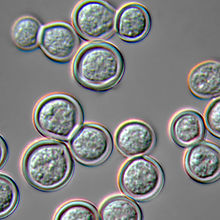Blastomyces
| Blastomyces dermatitidis | |
|---|---|
 |
|
| Blastomyces dermatitidis, yeast form | |
| Scientific classification | |
| Kingdom: | Fungi |
| Division: | Ascomycota |
| Class: | Eurotiomycetes |
| Order: | Onygenales |
| Family: | Ajellomycetaceae |
| Genus: | Blastomyces |
| Species: | B. dermatitidis |
| Binomial name | |
|
Blastomyces dermatitidis Gilchrist & W.R.Stokes (1898) |
|
Blastomyces dermatitidis is the causal agent of blastomycosis, an invasive and often serious fungal infection found occasionally in humans and other animals in regions where the fungus is endemic. The causal organism is a fungus living in soil and wet, decaying wood, often in an area close to a waterway such as a lake, river or stream. Indoor growth may also occur, for example, in accumulated debris in damp sheds or shacks. The fungus is endemic to parts of eastern North America, particularly boreal northern Ontario, southeastern Manitoba, Quebec south of the St. Lawrence River, parts of the U.S. Appalachian mountains and interconnected eastern mountain chains, the west bank of Lake Michigan, the state of Wisconsin, and the entire Mississippi Valley including the valleys of some major tributaries such as the Ohio River. In addition, it occurs rarely in Africa both north and south of the Sahara Desert, as well as in the Arabian Peninsula and the Indian subcontinent. Though it has never been directly observed growing in nature, it is thought to grow there as a cottony white mold, similar to the growth seen in artificial culture at 25 °C (77 °F). In an infected human or animal, however, it converts in growth form and becomes a large-celled budding yeast. Blastomycosis is generally readily treatable with systemic antifungal drugs once it is correctly diagnosed; however, delayed diagnosis is very common except in highly endemic areas.
Blastomyces dermatitidis is the causal agent of blastomycosis, a potentially very serious disease that typically begins with a characteristically subtle pneumonia-like infection that may progress, after 1–6 months, to a disseminated phase that causes lesions to form in capillary beds throughout the body, most notably the skin, internal organs, central nervous system and bone marrow. Blastomyces dermatitidis is the name applied to the ascomycetous fungus, Ajellomyces dermatitidis. In 2013, a second species was described in the genus Blastomyces, B. gilchristii, which subsumes certain strains previously assigned to B. dermatitidis. Despite widespread use, the genus Blastomyces is currently invalid under the International Code of Botanical Nomenclature. Along with two other important human-pathogenic fungi, Histoplasma capsulatum, Paracoccidioides brasiliensis and Polytolypa hystricis, species of Blastomyces belong to a recently recognized fungal family, the Ajellomycetaceae. The three principal pathogens in this family are all grouped physiologically as “dimorphic fungi”: fungi that switch from a mold-like (filamentous) growth form in the natural habitat to a yeast-like growth form in the warm-blooded animal host. Blastomyces dermatitidis itself is a sexual organism, occurring in nature as both a + mating type and a − mating type. This is epidemiologically important for two reasons: firstly, it implies that the organism will be genetically variable, potentially leading to variations in disease severity, treatment response and habitat preference; secondly, it implies that a suitable, stable habitat must exist for the complex process of sexual reproduction to take place. This habitat is as yet unknown. In its asexual form, the fungus grows as a typical colonial microfungus, comparable to Penicillium or Rhizopus mold forms commonly seen on mouldy bread.
...
Wikipedia
